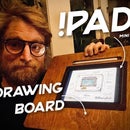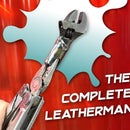Introduction: Cine Ambulante, the Traveling Cinema
I love analog tech, as you'll see I really can't get enough of these vintage marvels of engineering. I grew up with 8mm projectors, my father would show cartoons at my birthday and I even brought with me an 8mm camera as an exchange student in Australia (I sent the films back home so my family could develop and watch them) That is how old I am:-) So when I find these gems at the dump where people have left them to die, I die a little too.
In this project, I've been able to combine almost everything I love about making, box building, electronics, welding, and 3D printing. Restoring and reusing these long-gone entertainment systems have been a fantastic ride (you'll see it's actually been a ride!)
Hope you enjoy my journey to make Cine Ambulante, the traveling cinema.
Supplies
Analog revival list:
- 8mm projector with mechanical drive motor, simple controls. Most of them work, but driver belts are often broken and lamps are dead, you can find replacements online here: https://van-eck.net
- Slide viewers are often ok but lamps are harder to come by. Upcycle with 10 watts led.
- Walkmans are great, they just keep on working, most often the battery acid from leaving them in over a decade or two can harm the electronics, but try a fine metal brush to remove the acid attack.
- Speakers are all over the place, for this type of project you will not need hi-fi sound quality:-)
- Old car batteries can be fixed, check this instructables: www.instructables.com/id/Bring-Dead-Lead-Acid-Bat...
- Old bikes are the best, they look cool and the frames are often indestructible, find them at any dumpster. For welding iron is preferable, newer bikes are often aluminum (harder to weld good)
Step 1: Where It All Began…
I've been collecting 8mm film for a while now. Found footage is an art form and the randomness intrigues me. This started with the idea of making a portable projection unit from an old 8mm projector and a discarded slide viewer rescued at the dump. I wanted to make a trolly so I could bring this entertainment system to outdoor locations. This meant I had to add a battery solution and sound system to the rig. The first challenge, have the projector work on 12 volts and change the lamp inside the slide viewer to a led light source.
Step 2: 8mm Projector Surgery
This task was a little daunting at first because my electrical and mechanical skills aren't the best, but with much else I do, I tell myself "how hard can it be?" I started pulling out the electronics and found a 12 volts motor that would fit perfectly, the start-stop rewind functionality was replaced with a board that could drive the motor forward/backward and have speed adjustments.
Now what wasn't available anywhere was a new pully for the motor to drive the projector belt. So this was a great chance to dive into the possibilities of 3D printing. After a couple of test prints, I found the right size and form. A beveled middle would keep the belt straight. With the Dremel, I cut open the front panel and inserted the buttons and knobs for player functionality. I heat bent a piece of acrylic to fit where the old display panel had been.
All the way rough I would test the wiring and see if the motor worked as needed. The motor would need to reach a high RPM and have enough torch to run the machinery. The light was put on a separate switch so the motor and led would need two power inputs each. This made it simpler for me to troubleshoot as well. Also when rewinding the film I could turn off the light and save battery. Adjusting the light source was a little hard because the light gauge is so small (remember it's 8mm) but I fund a solution and made a custom heat sink for the 10watt led, I had a light focusing lens to direct as much light as possible through the projector lens.
I'll admit this took some failing and testing of my patience but I eventually got it to work!
Step 3: Now a Little Easier Fix…
The slide projector was a simpler workover. I removed the old lightbulb fixture and replaced t with a 10watt led attached to an aluminum custom-built heat sink. I wired it up to a DC input connector and an external battery pack as a secondary power option.
Step 4: Box Bonanza!
The great thing about old tech is that it is so much more rugged than the digital sh#$t we use today. Back then most stuff you bought came in boxes and were made to last. So to continue this tradition I had to make boxes for the projectors, good thing I love making boxes:-)
Since it all was going to be transported outside the whole trolly needed to be built for rough handling. Most of my box building involves the use of wood scraps and leftover plywood from the workshops I frequent.
Step 5: Sound Check… 1-2, 1-2
Since the projectors are both silent I needed to have a sound system added to the rig. This would sit perfectly below the projectors and be fitted with two speakers from an old broken stereo. The speakers would be connected to an amplifier so I could add audio from different input sources. But guess what, I already knew what would be the backbone for the sound input, Walkmans! I've been collecting these beauties for a long time and a good friend who works at the dump keeps me with a steady supply. What I want with these walkmans is to compose a random stream of music/audio for the screenings. Much of what I've collected through the years are a good mix of commercial movie titles and a heap of random found footage.
Step 6: Found Audio
Since I have four available tracks I can have som ambient music but for the most part I like playing found audio. I've got language cassettes (Arabic, Chinese, Polish and more) there are recordings from police radios and after listening to a 99% invisible podcast (https://99percentinvisible.org/episode/numbers-stations) I downloaded number stations from YouTube.
I've also collected found cassettes at thrift stores with speeches and motivational talks. When these types of audio clips are mixed and overlayed the projections you get som unexpected cool scenes.
Step 7: Mixing It Up
To be able to play a random piece of audio I needed to hook up more than one cassette player, so I had a go at making a passive audio mixer. Here came good help and advice from fellow maker friends in handy. I got this diagram drawn up to see what wiring goes where and the resistors (1K ohm) make the sound equal for the output.
When all the soldering were done and I tested it I realized I'd screwed up the wiring when turning the potentiometer, the volume was turning in the wrong direction! So another half hour of resoldering and the mixer was close to done. The casing is an old connector box (doorbell?) found in the trash.
I made some wooden pieces for the inner parts to stick to. Now I can mix 4 walkmans in mono and with the master volume, I can connect it to the stereo amplifier.
Step 8: Power Station
So with a projector, slide viewer, amplifier, lights and walkmans I needed a place to hold the power supply. I finally got to use our old car battery which was still good enough for this operation. This would be the biggest box and the heaviest of them all, also I needed to make sure it was stable and anchored for all the bumps ahead.
Inside the battery box, I wired up two main outlets for car battery connectors, one for the 8mm projector and one with 3 ports for different usages. A mains switch and a volt reader so I could see when the battery needed recharging.
I used found car battery chargers with coiled cables. some were fitted with fuses, most important I needed to have enough amp throughput for the film projector to run, at least 2 Amps.
Step 9: The Trolley Is Ready and Steady…
The trolley was now ready to assemble with all its boxes and contents. All these parts add up to a lot of weight and I had to attach the lower containers with bolts to the trolley frame in the back. First I thought some large scooter wheels would be enough but with the heavy-duty setup it didn't roll very well, so I leveled up and found some old children's trolley wheels, they turned out great, Air-filled and rugged they could hold the load easy. At the bottom, I added a drawer for extra equipment and cables.
Step 10: All Dressed Up and Ready to Roll… Ehhh
I was super happy with the paint job and branding and could not wait to get this out the door and have my first screening, buuuuut almost right away I found the trolly to be cumbersome to handle and rolling all the way into my city center would be a drag… Then out of the blue, my neighbor knocked on the door and wondered if I could have use of an old bike frame. Oh yes, I would!
This is where the traveling cinema really was born.
Step 11: Meet My Freak Bike!
This next step meant welding and constructing the front so it could hold the projection, battery and sound unit. I had old bike parts left over for a tall bike workshop and the quickest and the best solution was to add the front wheel to a bike fork.
The base frame for the box was welded onto this front part and adjusted so I could fit a sturdy one wheel at the front. A wheelbarrow wheel was the perfect solution (coincided with watching Laura Kampf beer bike build). This part of the project was a real joy, getting to weld and then having the pleasure of seeing you freak bike was actually ridable, a god day indeed:-)
A spring was necessary for the handlebars to stay straight and not get pulled by the weight to one side when turning. When stopping there needed to be feet for the rig to be stable, a spring was added here as well and had the same functionality as motorbike feet has.
Now you're thinking, will this roll and will it be possible to ride. Hell yeah!
Step 12: Getting the Show on the Road
I can promise you it was pure satisfaction riding this the first time, even the second, third… you get it, so much fun!
Why I named it Cine Ambulante, I imagine some Spanish boy a few decades ago riding this bike around the Andalucian hillsides entertaining villagers with corny films and imagery accompanied by music and found audio. Now I bring his legacy into our digitally overcrowded world, people get really excited when they recognize the 8mm films and vintage slide viewer.
The walkmans bring on smiles and echo the simple analog past. I really care for these audiovisual marvels of their time and find great pleasure in keeping the legacy alive, analog is not dead!
With Norway's light summer nights there are some challenges to the art of wall projections outside but there is a small window in the spring and early fall when not too cold or windy, so if you're ever in the area you might get to experience the Cine Ambulante, and if not, I hope you've enjoyed my build process:-)
Step 13: Epilogue…
My mission for sharing this instructable is to inspire others to dive into making analog projects. Meeting people and talking about the Cine Ambulante process awakens an enthusiasm that is often overwhelming, so much of this technology is part of everyone's history. Good memories come to mind when you see the walkman or the 8mm projector you maybe last saw at your grandparent's house or most probably their attic.
So next time you're at the landfill/dumpster ask politely if you can please do some analog surgery and bring old forgotten tech back to life. I'll be your general surgeon at your side:-)
You can find more of my work in progress at Instagram: https://www.instagram.com/smogdog




